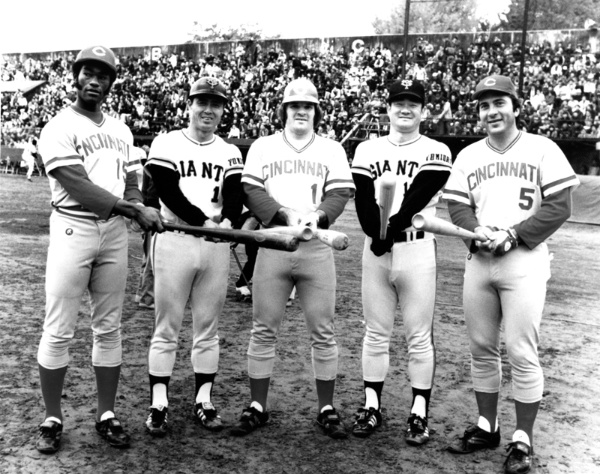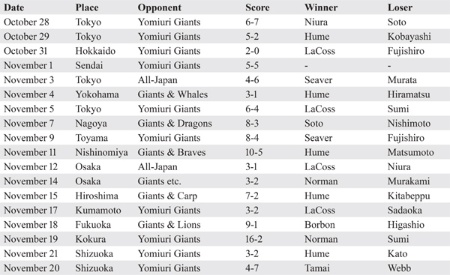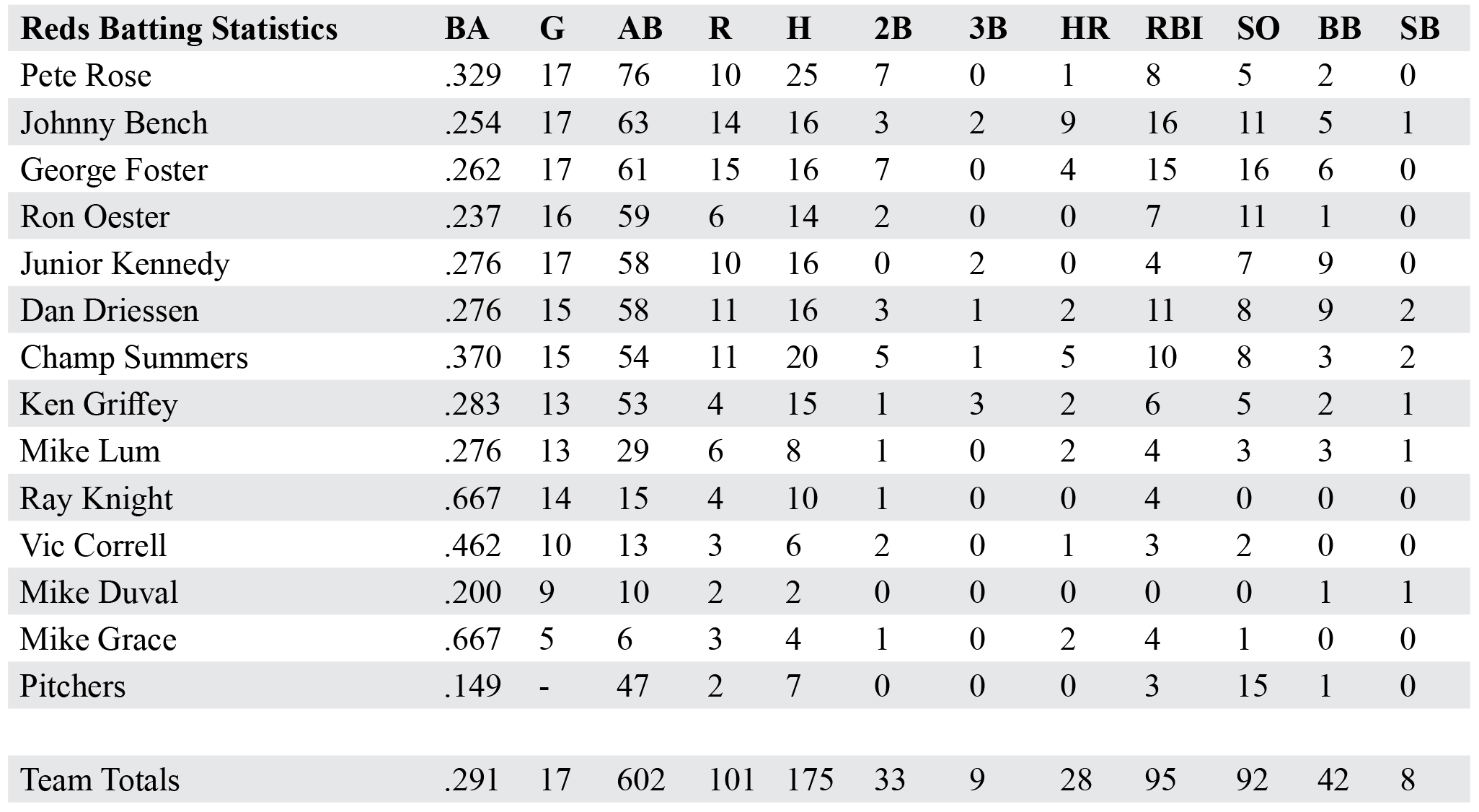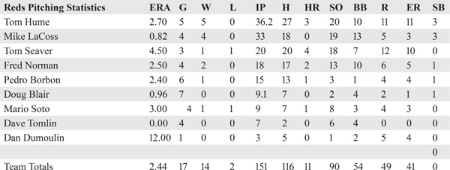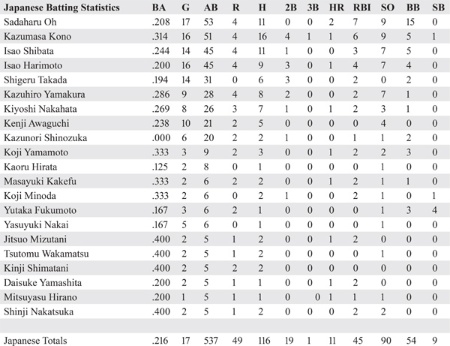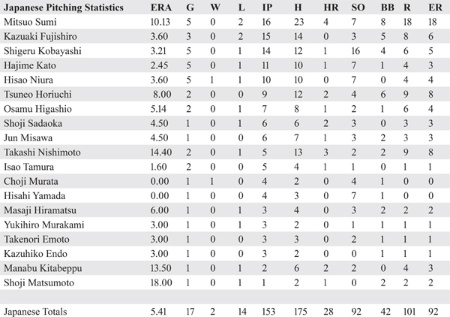The Big Red Machine’s Last Hurrah: Cincinnati Reds Tour of Japan, 1978
This article was written by Robert Kiyoshi Shadlow
This article was published in Nichibei Yakyu: US Tours of Japan, 1960-2019
From left to right: George Foster, Sadaharu Oh, Pete Rose, Isao Harimoto, and Johnny Bench. (National Baseball Hall of Fame Library, Cooperstown, New York)
Pete Rose basked in the attention he was receiving from the Japanese press on Opening Day, April 6, 1978. His Cincinnati Reds were facing the visiting Houston Astros in a game that was being broadcast live to Japan. Rose interrupted the Japanese interpreter by boisterously proclaiming, “Let me answer that. I speak Japanese well. No, I won’t do it today, but I’ll do it tomorrow.” Then the interpreter explained to Pete, that the question was, “How do you feel?”1
The 11-man Japanese press corps was on a 10-day visit to Cincinnati, Dallas, New York, and San Francisco. Yasushi Matsui of Fuji Telecasting Company said, “[T]he demand and interest in American baseball is there (in Japan).” Two major-league baseball games per week were being broadcast to Japan for the first time in 1978.2 The Japanese reporters and photographers were also excited about the Big Red Machine’s coming 1978 postseason tour of Japan. Rose addressed Japanese fans, “Tell ’em we’re going to beat the hell out of their teams. … We want to win the World Series this year so we can go to Japan and win the world, world series.”3
From 1970 through 1976, the Big Red Machine averaged 98 wins a season as they won five division titles and made four World Series appearances, winning two of them. The Reds featured Hall of Famers Johnny Bench, Joe Morgan, and Tony Perez along with Pete Rose, Dave Concepción, George Foster, César Gerónimo, and Ken Griffey Sr.4 The Reds declined a tour of Japan after winning the 1976 World Series. A few months later, Perez was traded from the Reds to the Montreal Expos and another future Hall of Famer, Tom Seaver, was sent to Cincinnati from the New York Mets in 1977.
In early December 1977, two or three major-league teams were being considered for a tour of Japan after the 1978 season. Commissioner Bowie Kuhn acknowledged, “There are a few teams who would like to go.” In October 1977, for example, Philadelphia Phillies traveling secretary Eddie Forenz was in Japan investigating accommodations for the Phillies.5 But on January 2, 1978, the Reds announced that the Japanese newspaper Yomiuri Shimbun would sponsor the team’s four-week tour of Japan beginning in late October 1978. They would face the Yomiuri Giants as well as combined teams throughout Japan.6
On May 26, 1978, Kuhn left for Japan for discussions about the Saturday and Monday Game of the Week broadcasts as well as This Week in Baseball. All three shows were being broadcast for the first time in Japan in 1978. The All-Star Game, league championships, and World Series were also scheduled to be shown in Japan that year.7 Kuhn was also preparing the way for the Reds’ postseason tour of Japan. Seventeen games were to be played in 13 cities: Tokyo, Sapporo, Sendai, Yokohama, Nagoya, Toyama, Nishinomiya, Osaka, Hiroshima, Kumamoto, Fukuoka, Kita-Kyushu, and Shizuoka.8
In 1978 Cincinnati had a strong 28-18 start by Memorial Day and was 49-37 at the All-Star break. A hard-fought season left them 2½ games behind the Los Angeles Dodgers in the National League West Division despite a 92-69 record before they embarked on the excursion to Japan.9 Cincinnati finished second in runs scored in the National League. The Big Red Machine’s offense was led by George Foster’s 40 home runs and 120 RBIs. There was hopeful speculation of a home-run-hitting contest between Foster and Japanese home-run king Sadaharu Oh.10 Johnny Bench hit 23 home runs while 37-year-old Pete Rose tied the 44-game National League single-season hitting streak record and recorded his 3,000th career hit. Tom Seaver won 16 games in 36 starts with a 2.88 ERA while Doug Bair had 28 saves with an ERA of 1.97.
The Reds’ roster for the trip to Japan consisted of a 10-man pitching corps of Doug Bair, Bill Bonham, Pedro Borbón, Dan Dumoulin, Tom Hume, Mike LaCoss, Fred Norman, Mario Soto, Dave Tomlin, and Tom Seaver. Catchers were Johnny Bench and Vic Correll. Their six infielders were Dan Driessen, Mike Grace, Junior Kennedy, Ray Knight, Ron Oester, and Pete Rose. Outfielders Mickey Duval, George Foster, Ken Griffey, Mike Lum, and Champ Summers made the trip.11 Reds manager Sparky Anderson brought six coaches: Alex Grammas, Ted Kluszewski, Russ Nixon, Ron Plaza, George Scherger, and Larry Shepard.
Technically, Mike Lum and Pete Rose, who had filed for free agency, were not members of the Reds. The Japan tour was significant for Lum, the first American-born player of Japanese ancestry in the majors. His mother was Japanese. Mike acquired the Lum surname when he was adopted by a Chinese couple.12
Paul Moskau was enraged when he found out that he was left off the Reds’ roster for the Japan tour. Moskau, already disenchanted after being sent to the minors at the end of spring training, exclaimed, “You feel like you are part of the team and twice they do this. Is Bonham going? Last time I talked to him, he was, with his arm in a cast.”13
Four other Reds players not making the trip were Davey Concepción, César Gerónimo, Ken Henderson, and Joe Morgan. Concepción wanted to stay in Venezuela to play winter baseball, while the other three were healing from injuries.14
Cincinnati farmhand Mickey Duval was one lucky guy. “[T]he Nashville Sounds (Double A) brought me to extended fall baseball in Tampa … and I did get to play with the big club for a month, but it was in Japan. When I was in Tampa, I was crushing it. I had a good year in Double A, and then [the Reds] said, ‘Do you feel like going to Japan? Gerónimo can’t make it.’ I got $9,000 for that month; I was only making $850 a month!”15
Accompanying the Reds was a delegation led by Kuhn, National League President Charles Feeney, and Reds President Dick Wagner along with six members of the Cincinnati front-office staff. National League umpire Lee Weyer also went along.
As they left, comedian Bob Hope said, “The only advice I have for them is have their kimonos made here. They’ll fit better. I can’t wait to see Johnny Bench in a kimono with rice in his hair.”16
On October 25, 1978, the Reds flew off to Japan and landed with Pete Rose sliding headfirst into commercial endorsements from Japanese companies like Mizuno.17 Pete acknowledged that he was accompanying the team despite being a free agent because he had business commitments in Japan. He even observed, “[The Japanese] might want me to play there next year too.” The Associated Press reported that at least one member of the Reds was in discussions about playing in Japan in 1979.18
The Reds contingent was greeted by cheering fans at Tokyo’s Narita Airport. At the welcoming press conference, Rose said, “I’m very happy to be here. I’m very curious to see and watch the reaction of Japanese fans and baseball players.” Sparky Anderson declared, “The Japanese are going to see some super baseball. I’m sure we will show some real fine baseball. … Japanese ballplayers and fans will agree that we were one of the finest major league teams to ever visit here.” Bench added, “Fans here will be in for some fine baseball, and it will be hard for (the Japanese) to believe the way Foster hits balls over the wall.” For his part, Foster promised, “I’ll give it my best shots.”19
The Big Red Machine started working out in smoggy Korakuen Stadium in Tokyo less than 24 hours after landing in Japan. “Ohayo Gozai Masu (Good Morning),” Johnny Bench greeted Japanese photographers. Anderson warned the players who were still suffering from jet lag, “Nobody will get crazy.” Infielder Dan Driessen remarked about the jet lag, “It’s manageable right now. It’s totally a new experience (to play in Japan).” Reds coach Alex Grammas promised, “[The Japanese fans] are expecting us to win, and we are going to win.” Meanwhile, Pete Rose boasted that he had turned down an offer to play for the Seibu Lions for “more than a million dollars.” He added, “Yes, I’ll play in Japan … 17 games (for the tour).”20
Game 1: October 28, Tokyo
Cincinnati faced the Yomiuri Giants in front of 47,000 rain-drenched fans at Korakuen Stadium. The lead changed hands four times before Kiyoshi Nakahata launched a game-winning two-run homer off reliever Mario Soto in the eighth inning to give the Giants a 7-6 victory. Foster and Champ Summers had home runs for the Reds.21
Sadaharu Oh touched starter Tom Seaver for a two-run home run in the bottom of the fourth. Seaver was on his second tour of Japan after having been on the 1974 New York Mets visit. Cincinnati players welcomed the charcoal fire pits in the Korakuen Stadium dugout to keep warm.22
Game 2: October 29, Tokyo
Some 50,000 Korakuen spectators watched as the Reds defeated the Yomiuri Giants 5-3 behind George Foster’s two-run double and a solo homer by Johnny Bench. Sparky Anderson said, “I felt good today. I asked my players to play an aggressive game from the start.” Anderson was particularly satisfied because Sadaharu Oh flied out with the bases loaded in the fourth inning.23
During the postgame press conference, Anderson exclaimed, “We are not hitting well. We have to be very aggressive. The Giants are fundamentally good.” Yomiuri reliever Shigeru Kobayashi gave up the home run to Bench, who noted, “He might be a good reliever (if he was in the major leagues).”24
Game 3: October 31, Hokkaido
Bench cranked out his second home run of the tour off reliever Mitsuo Sumi at Murayama Stadium in Sapporo. Mike LaCoss gave up only one hit in the 2-0 win over the Yomiuri Giants in front of 24,000 chilly fans. Snow-capped mountains were visible in the background. Anderson said, “I don’t feel good in a close game like today. LaCoss did a fine pitching job. We didn’t think much of the cold weather because we had experienced it in Montreal and San Francisco. My batters are gradually picking up.”25
Giants manager Shigeo Nagashima gave high marks to his starting pitcher, Kazuaki Fujishiro, who had pitched only three innings during the 1978 season: “I thought he could go all the way, but he got tired in the eighth. But I gave him a passing mark for holding the Reds scoreless in the first seven innings.”26
Game 4: November 1, Sendai
The Reds and Giants came away with a 5-5 tie. Ken Griffey went 3-for-5 with a home run and a triple. Johnny Bench hit his third homer of the tour in front of 30,000 fans in Sendai.27
One thing that stood out to the Americans was that teenage girls in cheerleader outfits served as batgirls during the game. After each use, they would take bats off the field to be cleaned and polished, then returned to the bat rack.28
Wherever the Cincinnati Reds went, their equipment manager, Bernie Stowe, went with them. Stowe said, “When we’re traveling, I’ve got to make sure everyone has the proper equipment. That it’s all packed and that it gets to the hotel and ballpark. I do it all by myself. If you get a system going, it’s not too bad. Everything falls into place.”29
Game 5: November 3, Tokyo
For the first time on the tour, the Yomiuri Giants were not the opponents when the Reds returned to Tokyo. Tom Seaver faced the Japan All-Stars and gave up three runs, eight hits, and two home runs, and walked three while striking out eight in seven innings.
Koji Yamamoto, Daisuke Yamashita, and Masayuki Kakefu homered the Japanese past the Reds, 6-4, in front of 50,000 spectators at Korakuen. After the game, Sparky Anderson remarked, “Since the Japanese players have made so much progress, Japanese teams can play US major league teams any time now and be competitive.”30
Game 6: November 4, Yokohama
The Big Red Machine rumbled into sunny Yokohama where they faced a combined team of Taiyo Whales and Yomiuri Giants. A crowd of 30,000 saw Cincinnati use timely hitting and good baserunning to pick up a 3-1 victory. Anderson praised his starting pitcher: “(Tom) Hume did a fine job pitching today. He had good control.”31 Sparky added, “[T]he Reds will play better in the remaining games.”32
There was a scare in the first inning when Ken Griffey was hit on head by a throw as he reached first base. He was stunned and fell to the ground but was able to walk to the dugout and was not seriously injured.33
While on the tour, Pete Rose received the news that 12 major-league teams had selected him in the free-agent draft. Rose exclaimed, “I was happy with the way it turned out. All the teams that I mentioned I would like to play with, except Boston, picked me. Most of them are contenders for a chance to win (the World Series) and all are offensive teams.”34
Game 7: November 5, Tokyo
The series returned to Korakuen Stadium, where the Reds defeated the Yomiuri Giants. 6-4. Bench hit his fourth home run of the tour in front of a crowd of 50,000. The Big Red Machine faced the Giants in nine of the 17 contests on the tour.35
Game 8: November 7, Nagoya
The series moved to Nagoya in central Japan as Cincinnati faced a combined Chunichi Dragons and Yomiuri Giants squad. Some 27,000 fans at Dragons Stadium saw Bench slug two home runs and Driessen and Lum one each. The four homers were part of a 13-hit attack that propelled the Reds to an 8-3 victory.36 Those three hitters each were presented with a bouquet of flowers as they crossed home plate after their home runs.37
National League umpire Lee Weyer was the only American arbiter on the tour. He said the Japanese players were courteous but noted, “I understand this year [the Japanese] had an argument which lasted one hour and 19 minutes. You would never see that in the United States.” Weyer observed that strikes were higher and that pitches at the knees are called balls.38
Game 9: November 9, Toyama
Seaver pitched seven innings, giving up four runs, six hits, and two walks, and striking out seven Yomiuri Giants in front of 22,000 fans in Toyama. The Reds won, 8-4. Isao Harimoto hit a home run off Seaver.39 The day before, Seaver had signed a five-year contract with the Reds. The 33-year-old right-handed pitcher said, “I am very happy with the contract and I’m looking forward to very productive years with the Reds.”40
Game 10: November 11, Nishinomiya
The Big Red Machine rolled over a combined Hankyu Braves and Yomiuri Giants team, 10-5, in Nishinomiya. Some 27,000 spectators watched Tom Hume win his third game of the tour despite the Japanese team leading through five innings. Champ Summers had two solo homers and Dan Driessen lifted a two-run round-tripper to lead the Reds’ 15-hit attack.41 The Associated Press noted that Sadaharu Oh “dropped his bat and was convulsed with laughter” after Pedro Borbón threw him a “blooper” pitch.42
Game 11: November 12, Osaka
A crowd of 46,000 saw the Reds beat a Japan all-star team 3-1 in Osaka. Mike LaCoss racked up his third win of the tour. The Reds’ record so far: eight wins, two losses, and one tie.43
Game 12: November 14, Osaka
A combined squad of Kintetsu Buffaloes, Nankai Hawks, and Yomiuri Giants lost 3-2 to the Reds at Osaka Stadium. The smallest crowd of the tour so far, 16,000, saw Cincinnati extend its winning streak to seven games.44 With his fifth-inning double, Pete Rose had hit in all 12 games so far.45
Game 13: November 15, Hiroshima
Bench tallied his seventh home run of the tour. Two-run homers by Foster and Griffey plus solo blasts by Bench and Mike Grace powered the Reds past a combined Hiroshima Carp and Yomiuri Giants team, 7-2. Tom Hume won his fourth game of the tour, giving up two runs and seven hits.46
Manabu Kitabeppu gave up four runs in the first inning in front of a crowd of 20,000 at Hiroshima’s Municipal Stadium. Jitsuo Mizutani hit a two-run homer off Hume.47
Bench, whose homer was his seventh of the tour, joked, “Some guys are known as ‘money’ players, I’ve become a ‘chocolate’ player.” Japanese custom dictates that players receive 5,000 yen and a box of chocolate bars when they hit a home run. Japanese fans nicknamed Bench, “The Candy Man.”48
Game 14: November 17, Kumamoto
The Reds came from behind to defeat Yomiuri, 3-2, running their win streak to nine. Bench hit his eighth home run of the series and added a tiebreaking double in the seventh inning to win the game, played at Fujisakidai Stadium in Kumamoto, Kyushu, in front of 26,000 fans. Foster belted his third homer of the tour.49 Mike LaCoss picked up his fourth victory. Pete Rose extended his hitting streak to all 14 games of the series.50
Game 15: November 18, Fukuoka
The Big Red Machine kept getting stronger and stronger as evidenced by their 9-1 win over a combined unit of the Crown Lighter Lions and Yomiuri Giants at Heiwadai Stadium in Fukuoka. Foster’s two-run blast and solo homers by Summers, Grace, and Vic Correll provided the fireworks before a crowd of 34,000.51
Game 16: November 19, Kokura
Cincinnati pummeled the Yomiuri Giants, 16-2, before 27,000 at Kokura Stadium in Kokura. Mike Lum, Johnny Bench, and Pete Rose hit two-run homers. Giants pitchers allowed 18 hits as the Reds earned their 11th consecutive victory.52
Game 17: November 21, Shizuoka
A crowd of 20,000 at Shizuoka Stadium in Hamamatsu watched the final game of the tour, a 3-2 Cincinnati victory. Sadaharu Oh, who had 805 home runs at the end of the 1978 season, connected for only his second round-tripper of the tour. Pete Rose was held hitless after hitting safely in the first 16 games.53 Tom Hume, the winning pitcher, was the winningest pitcher of the tour with five victories. The Reds totaled 28 home runs. Bench led with nine. Champ Summers led the team with a .370 batting average.
The Reds tallied 14 wins, 2 losses, and 1 tie in the 17-game series. Cincinnati won the last 12 games in a row, “displaying power, speed, and the determination to win even though the games were exhibitions.”54 Against the Yomiuri Giants, who hosted the tour, the Reds had seven wins, one loss, and one tie.
As to whether Japan was ready to compete in a global world series, Bench observed, “Maybe in 10 years. Hitting-wise, they have fewer flaws, but they don’t match up.” Sparky Anderson said, “Their best teams could compete … but I feel they would finish fourth or fifth. Bench and Foster could probably hit 60 to 65 homers a season over there, maybe 70. The fences are very short.” Foster, who also toured Japan when he was with the San Francisco Giants in 1970, said, “It’s tough for them to compete with our power. They have some outstanding pitchers who could do well over here and a few hitters. But Americans are bigger and have strength in their favor. They had a lot of submarine pitchers. But they don’t throw much breaking stuff.”55
Pete Rose said of one unnamed Japanese pitcher whom the Reds nicknamed Spiderman, “He came to a stop at four different points during his delivery.” Rose also marveled at the Japanese love of baseball: “I never saw an empty stadium. We arrived at 7:30 one morning and a kids league already had three innings in.”56
Sadaharu Oh impressed Anderson. “Prior to our last game, (Oh) came over up to me … and apologized for his showing,” the manager said. “He’s played in every game since March 1st. He’s very tired.” The Reds equipment manager Bernie Stowe admired Oh, saying, “That man signed 250 autographs and never complained once. I’ve never seen anything like it.”57 Tom Seaver said, “I think Oh would hit about 25 home runs a year in our major leagues and maintain close to a .300 batting average. He’s 38 years old but has the body of a man 30 years old.”58
Cincinnati coach Alex Grammas remarked, “Japanese baseball has improved tremendously since I was here 20 years ago with the 1958 St. Louis Cardinals. The players are bigger, more skilled and gradually becoming better hitters. Defensively, their infielders are almost as good as our major leaguers. Their No. 1 weakness is the throwing arms of their outfielders.” Tom Seaver could see some improvement since his first visit with the New York Mets four years earlier. “Their pitchers are throwing harder than in 1974. They have excellent control. Pitching is the strongest part of Japanese baseball.” He encouraged Japanese players to strengthen their arms through weightlifting.59
Commissioner Bowie Kuhn, talking about a global World Series, said, “No timetable has been set yet. But there is feeling that it might be closer, if still down the road.”60
The Japanese cost of living and exotic cuisine surprised many on the tour. Pete Rose’s wife, Karolyn, was shocked that they paid $47 for “just a steak, nothing with it. The meal came to $150 for one person.” A roast-beef sandwich cost $30 and a martini $5.50. Karolyn also tried blowfish, which she found rubbery. Ramona Lum said her husband, Mike, of Japanese ancestry, “was in hog heaven.” Johnny Bench sampled jellyfish, octopus, and fish eggs. Champ Summers ate raw fish. But Mike LaCoss stuck to more familiar fare: “They had hundreds of McDonald’s joints … and pizza and ice cream parlors too.”61
The Reds returned to Cincinnati on October 22. That same day, Pete Rose assembled a conference to give Jeeps to nine members of the Reds staff, saying, “These guys are my MVPs.” Coaches Alex Grammas, Ted Kluszewski, Russ Nixon, Ron Plaza, George Scherger, and Larry Shepard, along with trainer Larry Starr, equipment manager Bernie Stowe, and broadcaster Joe Nuxhall each received a Jeep. Rose said Nuxhall “would get up on Christmas Eve to throw batting practice for me.” Rose also treated himself to a Jeep.62
Five days after returning from Japan, Sparky Anderson was fired. He had led the Reds for nine years to five division titles, four pennants, and two World Series championships.63 Anderson said, “I was totally shocked. We’d just got back from Japan, and it was a super trip. Dick (Wagner) even congratulated me on how we’d done.”64 Melvin Durslag wrote, “Sparky lived in the fantasy that he was part of the Cincinnati family. So he got his family reward – two and a half weeks of barnstorming in Japan and a kick in the kimono.”65
Pete Rose fumed about Anderson being ousted, saying, “I’d walk through hell in a gasoline suit for him.”66 Asked if he would consider signing with Cincinnati, Rose answered, “[T]he first thing I’d want would be for them to hire Sparky Anderson.”67 Rose said, “The Japanese have to think we got a bunch of kooks running this team.”68
One sportswriter, Fred Russell, speculated that Rose didn’t rule out eventually “playing a season or two [in Japan] when he’s about 45 years old.” Russell noted, “He has picked up $60,000 [$256,566 in 2022 dollars] while [in Japan], endorsing Japanese products.”69 Rose proudly wore and used anything with Mizuno on it – workout shirts, batting gloves, bats, gloves. Shortly thereafter, Pete signed a four-year contract with the Phillies for $3.2 million ($13,422,171 in 2022 dollars), the largest big-league contract at the time.70
ROBERT KIYOSHI SHADLOW was born to an American father and Japanese mother at the University of Tokyo Hospital in Bunkyo, less than a mile from Korakuen Stadium, the home of the Yomiuri Giants. However, his mother’s hometown was Otsu, Shiga-ken in the Kansai region and her family were predominantly fans of the Hanshin Tigers, the Giants archrivals. When he was 5 years old, Robert moved to the United States and faced considerable cultural shock. The one commonalty between the two cultures was baseball. Robert’s mother started clipping major-league baseball cards from the back of Post Cereal boxes. At the same time, his grandmother would send Japanese children’s magazines that would often feature articles, photos, and even cards about Japanese professional baseball stars. This inspired Robert to read as much as he could about baseball throughout the world. His baseball collection now encompasses cards and collectibles from Asia, Latin America, Europe, as well as North America. Because of the dearth of information on Asian baseball, Robert started a Japanese baseball newsletter and contributed writing to such websites as Baseball Guru and JapaneseBaseball.com.
1978 Cincinnati Reds Games in Japan (14 Wins, 2 Losses, 1 Tie)
(Click images to enlarge)
Notes
1 Associated Press, “Audacious Rose Charms (?) Visiting Japanese Writers,” Sarasota (Florida) Journal, April 6, 1978: C1.
2 Associated Press, “Pete ‘Tokyo’ Rose Proves to Be No Diplomat,” Lima (Ohio) News, April 6, 1978: 3-b.
3 Associated Press, “Pete Rose Turns Table on Japanese Reporters,” Corbin (Kentucky) Times-Tribune, April 6, 1978: 3.
4 Mike Fisk, “Big Red Machine: In Retrospect,” December 12, 2020, https://www.overtimeheroics.net/2020/12/26/big-red-machine-in-retrospect/.
5 Associated Press, “Phils Top List for Japan Trip,” Doylestown (Pennsylvania) Daily Intelligencer, December 3, 1977: 13.
6 United Press International, “Cincy Reds to Tour Japan,” Galveston Daily News, January 3, 1978: 2-B.
7 United Press International, “Bowie Kuhn In Japan,” Monessen Valley (Pennsylvania) Independent, May 27, 1978: 9.
8 Associated Press, “Reds to Invade Japan,” Big Spring (Texas) Herald, June 14, 1978: 2-B.
9 Dan Flaherty, “The Seasonal Narrative of the 1978 Cincinnati Reds,” September 27, 2021, http://thesportsnotebook.com/1978-cincinnati-reds/.
10 “Caught on the Fly,” The Sporting News, October 28, 1978: 28.
11 Lee Kavetski, “The Reds Are Coming!” Pacific Stars and Stripes, October 26, 1978: 23.
12 Rory Costello, “Mike Lum,” August 3, 2017, https://sabr.org/bioproj/person/mike-lum/.
13 Associated Press, “Moskau Lashes Out at Reds,” Middletown (Ohio) Journal, October 7, 1978: 10.
14 United Press International, “Five Reds Forgo Trip,” Defiance (Ohio) Crescent News, October 20, 1978: 22.
15 Jim Haught, “Mickey Duval: No Regrets,” 2021, https://haught corner.com/interview/mickey-duval-no-regrets/.
16 Associated Press, “Bob in Doghouse with Mrs. Hope,” Middletown (Ohio) Journal, October 24, 1978: 10.
17 Red Smith, “Pete’s New World,” Pacific Stars and Stripes, December 28, 1978: 22.
18 Associated Press, “Rose Looks Forward to Free Agent Draft,” Frederick (Maryland) News, October 26, 1978: C-3.
19 Associated Press, “Reds Arrive on Japan Tour,” Pacific Stars and Stripes, October 28, 1978: 19.
20 United Press International, “Reds Start First Workout in Japan,” Delphos (Ohio) Herald, October 27, 1978: 11.
21 Associated Press, “Reds Bow 7-6,” Xenia (Ohio) Daily Gazette, October 28, 1978: 6.
22 Associated Press, “Reds’ Japanese Tour Notes,” Elyria (Ohio) Chronicle-Telegram, November 15, 1978: D-7.
23 Associated Press, “Cincy Turns Back Giants by 5-3,” Pacific Stars and Stripes, October 31, 1978: 21.
24 United Press International, “Sparky Enthused at 1st Win,” Pacific Stars and Stripes, October 31, 1978: 21.
25 Associated Press, “Reds Shut Out Giants,” Pacific Stars and Stripes, November 2, 1978: 23.
26 United Press International, “Reds Capture Second Game,” Defiance (Ohio) Crescent News, October 31, 1978: 19.
27 Associated Press, “Reds, Giants Tie 5-5,” Pacific Stars and Stripes, November 3, 1978: 22.
28 Associated Press, “Reds’ Japanese Tour Notes,” Elyria Chronicle-Telegram, November 15, 1978: D-7.
29 Paul Long, “Bernie’s in Full Gear for Cincinnati,” Pacific Stars and Stripes, November 3, 1978: 22.
30 Associated Press, “All-Stars Stop Seaver, Reds 6-4,” Pacific Stars and Stripes, November 5, 1978: 22.
31 Associated Press, “Reds Take 3rd Win in Exhibition Tour,” Pacific Stars and Stripes, November 6, 1978: 21.
32 Associated Press, “Reds Take 3rd Win in Exhibition Tour.”
33 United Press International, “Reds Whip Japanese,” Elyria Chronicle-Telegram, November 4, 1978: D-2.
34 United Press International, “Pete’s Happy, Too,” Pacific Stars and Stripes, November 6, 1978: 20.
35 Associated Press, “Reds Pin 6-4 Loss on Giants,” Pacific Stars and Stripes, November 7, 1978: 21.
36 Associated Press, “Reds Blast Dragons,” Xenia (Ohio) Daily Gazette, November 7, 1978: 7.
37 Associated Press, “Reds’ Japanese Tour Notes,” Elyria Chronicle-Telegram, November 15, 1978: D-7.
38 “Umpire Expresses First Class Views,” Pacific Stars and Stripes, November 8, 1978: 19.
39 Associated Press, “Cincy Downs Giants,” Pacific Stars and Stripes, November 11, 1978: 23.
40 Associated Press, “Reds Sign Seaver to 5 Year Contract,” Pacific Stars and Stripes, November 9, 1978: 22.
41 Associated Press, “Cincy Wins 7th in Japan,” Pacific Stars and Stripes, November 13, 1978: 19.
42 Associated Press, “Reds’ Japanese Tour Notes,” Elyria Chronicle-Telegram, November 15, 1978: D-7.
43 Associated Press, “Reds Pin 3-1 Loss on Stars,” Pacific Stars and Stripes, November 14, 1978: 20.
44 United Press International, “Streak Hits 7,” Defiance Crescent News, November 14, 1978: 18.
45 United Press International, “Reds Win 7th Straight,” Delphos (Ohio) Herald, November 14, 1978: 7.
46 Associated Press, “Reds Roll to 7-2 Win,” Xenia Daily Gazette, November 15, 1978: 6.
47 United Press International, “Reds Bomb Tokyo,” Delphos Herald, November 15, 1978: 14.
48 Associated Press, “Reds’ Japanese Tour Notes,” Elyria Chronicle-Telegram, November 15, 1978: D-7.
49 Associated Press, “Bench, Foster Rip Giants,” Xenia Daily Gazette, November 17, 1978: 6.
50 United Press International, “Foster, Bench Propel Reds,” Defiance Crescent News, November 17, 1978: 25.
51 Associated Press, “Red Homers Key 9-1 Win,” Xenia Daily Gazette, November 18, 1978: 6.
52 Associated Press, “Reds Blast Giants,” Pacific Stars and Stripes, November 21, 1978: 22.
53 United Press International, “Reds Finish with Victory,” Defiance Crescent News, November 21, 1978: 22.
54 Associated Press, “Reds Tip Giants in Series Wrap-up,” Pacific Stars and Stripes, November 23, 1978: 22.
55 Associated Press, “Japanese Baseball 10 Years Away from Series-Caliber Play,” Dover-New Philadelphia (Ohio) Times-Reporter, November 23, 1978: C-1.
56 Associated Press, “Japanese Baseball 10 Years Away from Series-Caliber Play.”
57 Associated Press, “Japanese Baseball 10 Years Away from Series-Caliber Play.”
58 Fred Russell, “Reds’ Tour of Japan May Hasten Global Series,” The Sporting News, December 2, 1978: 52.
59 Russell.
60 Russell.
61 Associated Press, “Reds’ Yen for Japan,” Xenia Daily Gazette, November 25, 1978: 6.
62 Associated Press, “Presents Don’t Mean Farewell, but Race for Rose Picking Up,” Dover-New Philadelphia Times-Reporter, November 23, 1978: C-1.
63 Will Grimsley (Associated Press), “Junking the Red Machine,” Xenia Daily Gazette, December 1, 1978: 6.
64 Associated Press, “Unemployed, He’ll Play Lots of Golf,” Pacific Stars and Stripes, December 1, 1978: 24.
65 Melvin Durslag, “Some Reward for Sparky!” The Sporting News, December 16, 1978: 14.
66 Associated Press, “Pirates Move Up in Run for Rose,” Dover-New Philadelphia Times-Reporter, November 30, 1978: C-1.
67 Associated Press, “Street-Fighter Rose,” Pacific Stars and Stripes, December 7, 1978: 19.
68 Associated Press, “Reds’ Fans Erupt at Sparky’s Dismissal,” Pacific Stars and Stripes, December 1, 1978: 19.
69 Russell.
70 United Press International, “Hustling Really Paid for Rose,” East Liverpool (Ohio) Evening Review, December 6, 1978: 22.
71 Listed Japanese players have a minimum of 5 at-bats, 3 innings pitched, or a decision. Yoshikazu Matsubayashi, Baseball Game History: Japan vs, U.S.A. (Tokyo: Baseball Magazine, 2004), 101; Nippon Professional Baseball Records, https://www.2689web.com/nb.html.


